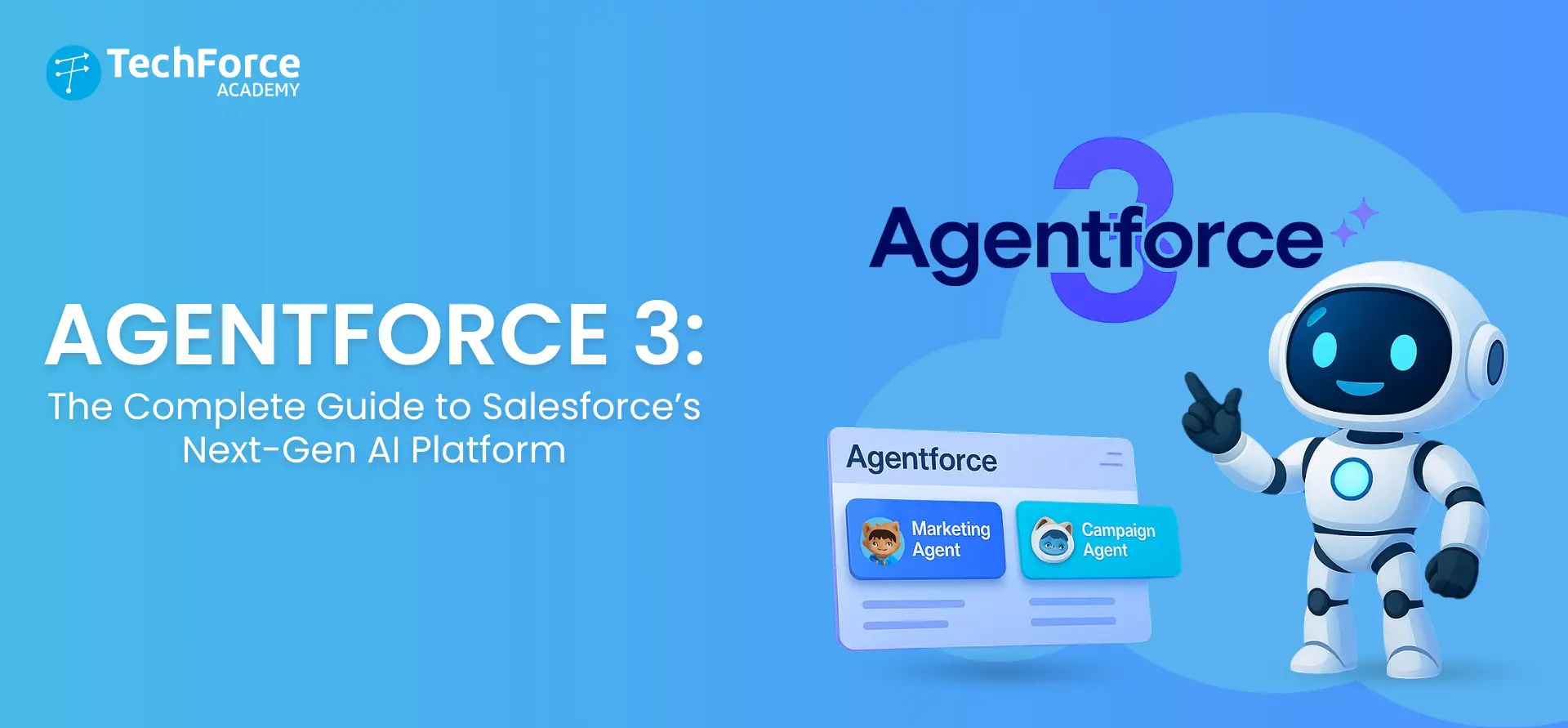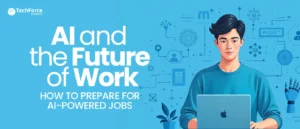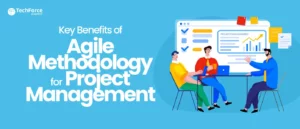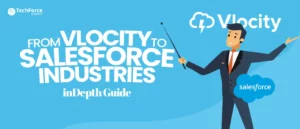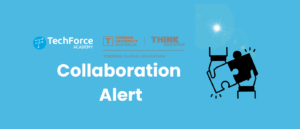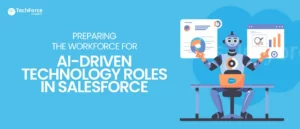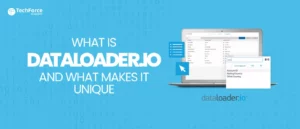The Rise of Agentic AI and Salesforce’s Vision
Salesforce is at the forefront of the revolution in artificial intelligence that is changing our workplace. In 2025, AI agents are becoming more than just a sci-fi concept; they are actual tools that assist businesses in increasing productivity, saving time, and offering superior customer service.
But, businesses encounter major challenges as they try to use AI agents: How can you see what your agents are doing? How do you control them? How do you make sure they work with your other tools? Salesforce’s Agentforce 3 answers these questions and more.
The Evolution of Agentforce: From Prototype to Enterprise-Ready Platform
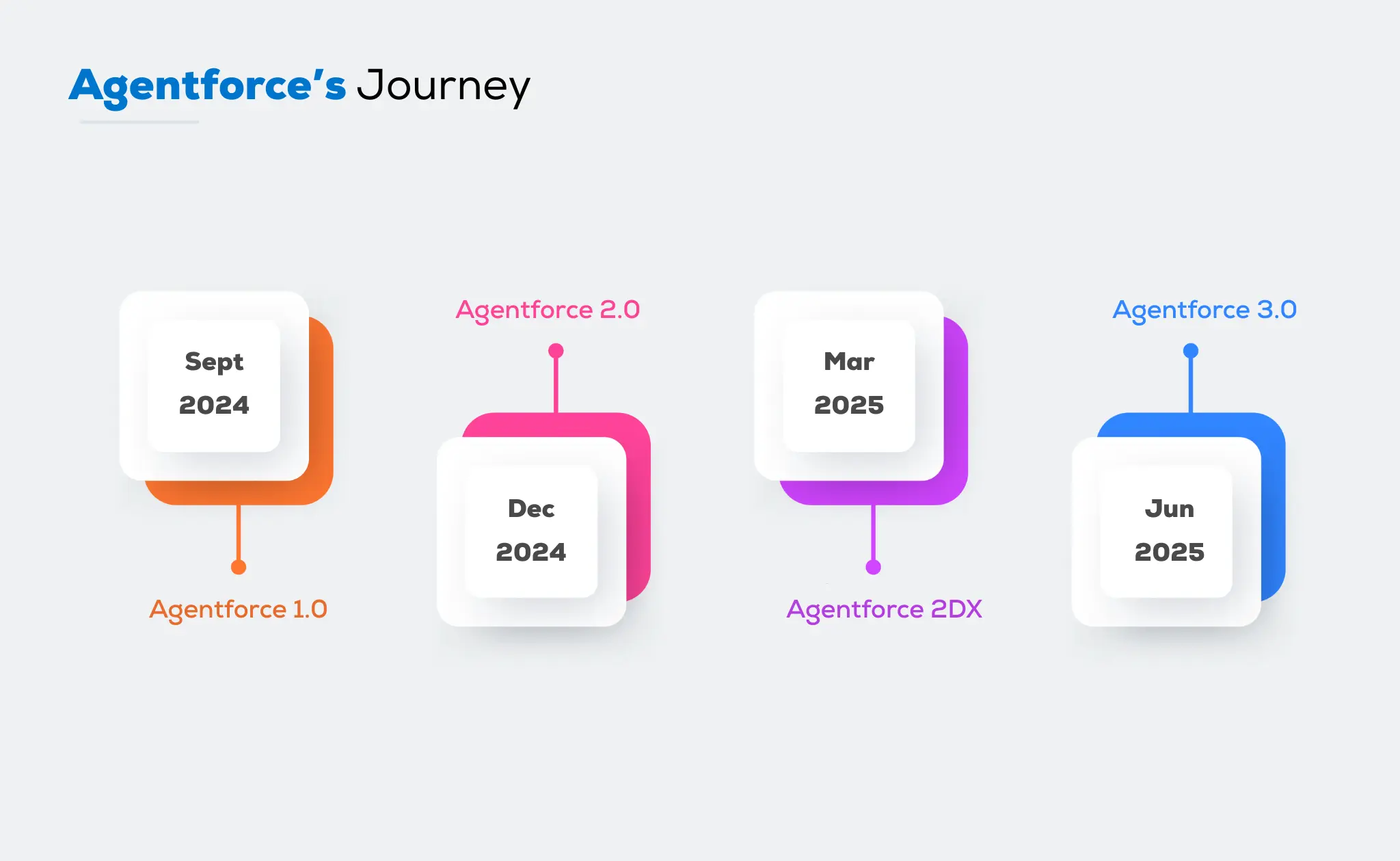
Agentforce’s Journey: Key Milestones
Salesforce launched Agentforce in September 2024. The first version, Agentforce 1.0, let companies automate basic tasks in sales, service, and marketing using AI agents built right into the Salesforce platform.
In December 2024, Agentforce 2.0 arrived, adding pre-built agent skills for Slack and Tableau, deeper MuleSoft integration, and the first version of the Atlas Reasoning Engine. This makes it simpler for businesses to employ AI agents for more complicated tasks and in more places.
By March 2025, Agentforce 2DX was released at TrailblazerDX. This update made agents more proactive and smarter, letting them handle more complex, multi-step processes and work better with company data.
Now, in June 2025, Agentforce 3.0 is here. This release is the biggest yet, with a new Command Center for full observability, plug-and-play integration using Model Context Protocol (MCP), an expanded AgentExchange marketplace, and over 100 prebuilt industry actions. Salesforce’s vision of a digital workforce is made a reality for businesses of all sizes with Agentforce 3.0.
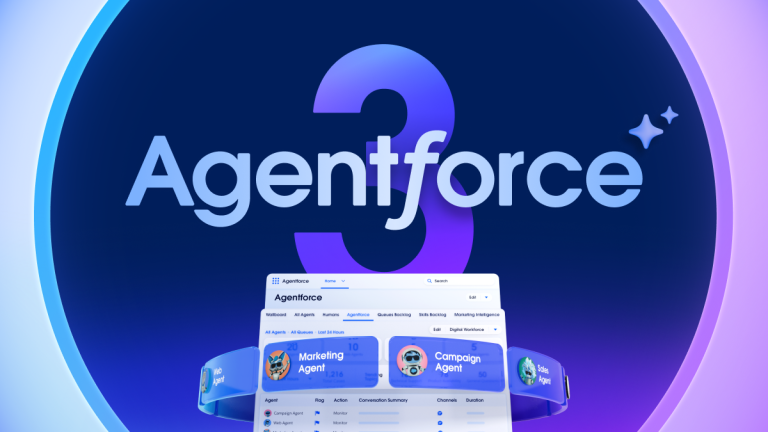
Image source: Salesforce
Listening to the Ecosystem: Addressing Real-World Concerns
Salesforce built Agentforce 3.0 based on feedback from thousands of customers. Users required more insight into their AI agents’ actions, more control over their actions, and simpler methods to connect their agents to the tools they previously utilised.
Pricing, governance, technology debt, and security were all areas of uncertainty for many professionals. In response, Salesforce introduced improved integration, flexible pricing, and transparency features that made it simpler for businesses to trust and scale their AI workforce.
Why Agentforce 3.0 Matters for Businesses and Professionals
Agentforce 3.0 is a big step forward. It tackles the three primary obstacles to AI adoption: control, visibility, and integration. Once these obstacles are eliminated, businesses may use AI agents to improve customer service, automate processes. They can boost productivity without sacrificing security or control.
Introducing the Agentforce Command Center: Observability, Governance & Optimisation
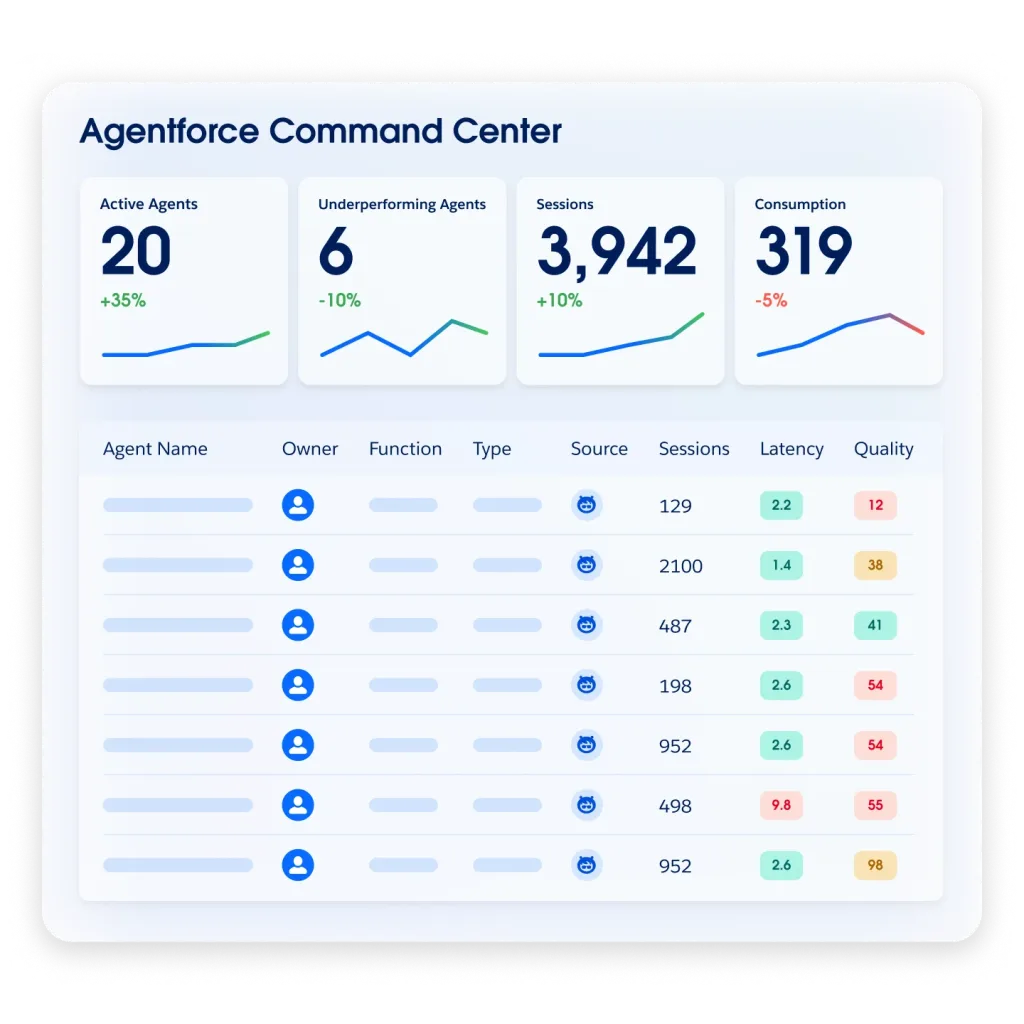
Image source: Salesforce Agentforce
What Is the Agentforce Command Center?
You can think of the Agentforce Command Center as your AI agents’ control room. It gives you a single place to monitor, manage, and improve all your agents across the company. This new functionality was created for the digital labor era, in which AI agents and humans collaborate.
Real-Time Monitoring, Alerts, and Analytics
The Command Center allows you to:
- Track agent health in real time, including error rates, performance, and escalations.
- Receive immediate notifications when something goes wrong so you can take quick action.
- Monitor important indicators such as agent adoption, case resolution time, and client satisfaction.
Session Tracing and Telemetry: End-to-End Visibility
You may track every agent interaction, examine conversations, and identify trends using the Command Center. You can drill down into specific sessions to see how agents handled different tasks, and use telemetry data to find areas for improvement.
Built on the OpenTelemetry standard and integrated with Salesforce Data Cloud, this telemetry provides end-to-end visibility and can be connected to tools like Datadog and Splunk for deeper analysis.
Customisable Dashboards for Every Team
Sales, service, marketing, and other departments can customise their dashboards to monitor metrics that are most important to them. In order to manage teams and identify trends, supervisors can easily see real-time wallboards that display both human and AI agent activity.
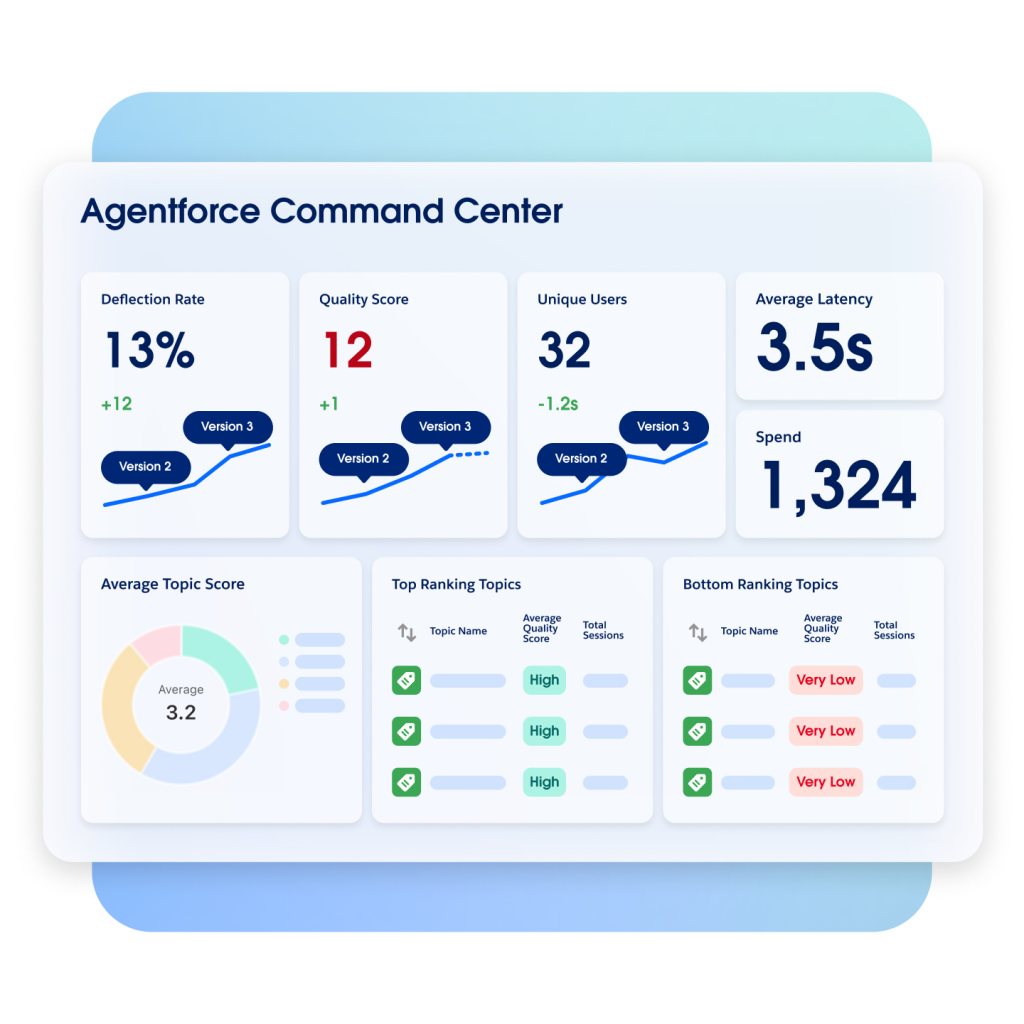
Image source: Salesforce Agentforce
AI-Assisted Development and Testing Tools
Agentforce Studio, part of the Command Center, uses AI to help you:
- Quickly create and test agents using natural language prompts.
- Simulate agent behaviour at scale before going live.
- Apply updates and new instructions easily, without writing code.
Session Testing and Backtesting (Telemetry Tools)
A standout feature is the new Testing Center. Teams can run session-based testing and backtesting—replaying real or simulated agent sessions to see how agents perform under different scenarios. This helps teams debug, optimise, and ensure agents meet business goals before they go live.
Pricing Model Enhancements
Salesforce has made Agentforce 3 more accessible and predictable for all organisations with new pricing options:
- Flex Credits: Instead of paying per conversation, companies can buy Flex Credits that can be used across different agent actions. This makes budgeting easier and more flexible.
- Usage-Based Pricing: For many use cases, pricing starts at just 10 cents per action. This low entry point encourages experimentation and scaling without fear of runaway costs.
- Unlimited Use Models: For employee-facing agents, companies can choose unlimited usage licenses, so they don’t have to worry about usage caps or surprise bills.
These pricing changes directly address concerns from the Salesforce ecosystem about ROI, cost predictability, and the need for scalable AI
Model Context Protocol (MCP): Plug-and-Play AI Integration
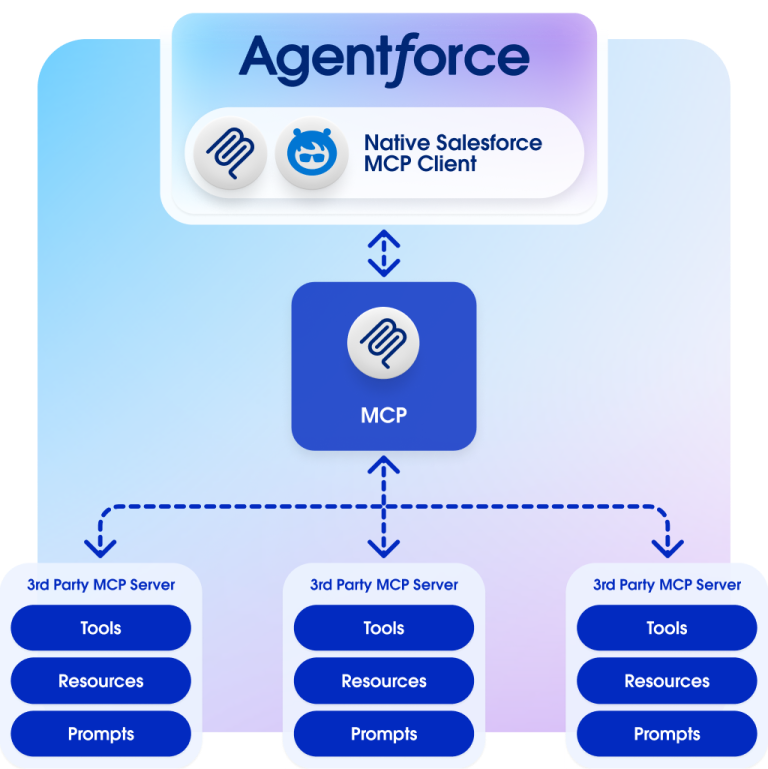
Image source: Salesforce-MCP Support
What Is MCP? The “USB-C for AI Agents”
Connecting AI agents to all your business tools used to be a headache. Each tool needed a custom integration, which was slow and expensive. The Model Context Protocol (MCP) changes this. MCP is an open standard that lets AI agents connect to any tool or data source that supports MCP—like a universal plug for AI.
Smooth Integration with Business Tools (MuleSoft, Heroku, Slack, etc.)
With Agentforce 3 and MCP, you can:
- Instantly connect agents to well-known platforms like Salesforce, Slack, PayPal, and Box.
- Use AgentExchange to access plug-and-play services from over 30 partners, including AWS, Google Cloud, IBM, Notion, Stripe, Teradata, and WRITER.
- Build custom MCP servers for your own tools, making it easy to add new integrations without lots of code.
Secure, Governed Agent Actions Across Platforms
Admins can use natural language to set guardrails for each agent. You decide what each agent can do, monitor all actions for compliance, and keep sensitive data safe.
The Unified Agent Gateway: Centralised Security and Policy Management
Agentforce 3 introduces a unified agent gateway, managed by MuleSoft, for centralised agent registration, identity, and policy management. This allows admins to set permissions, strictly regulate which agents have access to which tools, and guarantee that all agent activity complies with company security and compliance guidelines.
The AgentExchange: Building a Scalable AI Ecosystem
From AppExchange to AgentExchange: A New Era for AI Agents
Just as AppExchange changed how companies find and use business apps, AgentExchange is a new marketplace for AI agents. Here, you can find, deploy, and manage AI agents for all kinds of business needs.
30+ Plug-and-Play Partners: AWS, Box, PayPal, WRITER, and More
AgentExchange now offers services from over 30 partners. For example:
- PayPal: Agents can automatically generate and send compliant invoices.
- WRITER: Agents can automate content creation, knowledge retrieval, and compliance checks inside Salesforce.
- Box: Agents can fetch and summarise signed NDAs, then update teams in Slack with the key points and next steps.
Real-World Use Cases: Invoicing, Content Automation, Document Management
These integrations let companies automate tasks like processing transactions, managing documents, scheduling appointments, generating reports, and handling customer support.
Accelerating Time-to-Value with 100+ Prebuilt Industry Actions
Agentforce 3 comes with over 100 prebuilt actions for industries like healthcare, retail, finance, and more. This means you can start using AI agents right away, without building everything from scratch.
Atlas Reasoning Engine: Smarter, Faster, More Reliable
Enhanced Reasoning, Performance, and Trust
Agentforce is driven by the Atlas Reasoning Engine. With Agentforce 3, Atlas is faster and smarter than ever. It generates plans based on your business goals, uses web search to find up-to-date information, and delivers answers 50% faster than before. Real-time streaming responses mean users see answers as they are generated.
Multi-Model Support: OpenAI, Anthropic, Google Gemini
Agentforce 3 gives you more choices for the AI models powering your agents. You can use:
- OpenAI’s models.
- Anthropic’s Claude Sonnet, hosted securely via Amazon Bedrock.
- Google’s Gemini.
This flexibility is great for companies in regulated industries, which need to keep data secure and meet strict compliance standards.
Global Availability and Multilingual Support
Now, Agentforce 3 supports additional regions, such as Brazil, Japan, India, Canada, and the UK. It also adds six new languages—French, Italian, German, Spanish, Japanese, and Portuguese—with over 30 more coming soon.
Enterprise-Grade Reliability and Compliance (FedRAMP, etc.)
Agentforce 3 is built for the enterprise, with always-on reliability and compliance at its core. It features automatic model fallback—if one AI model slows down or fails, Agentforce switches to another behind the scenes, so your business keeps running smoothly.
It has achieved FedRAMP High authorisation, making it trusted for use by U.S. public sector organisations and meeting strict security requirements for regulated industries.
Business Impact: Real-World Results from Agentforce Customers
Agentforce 3 isn’t just about new features—it’s delivering real results for companies around the world.
- Engine: 15% less average time spent handling customer cases.
- 1-800Accountant: During busy tax weeks, 70% of administrative chat interactions were automatically resolved.
- Grupo Globo: Increased subscriber retention by 22%.
- PepsiCo and UChicago Medicine: A quick time-to-value was achieved using pre-built industry activities and flexible pricing.
These stories show how Agentforce 3 helps companies work smarter, serve customers better, and save money.
Critical Sentiment and Ecosystem Feedback
When Agentforce first launched, many Salesforce professionals were sceptical. They worried about security, technical debt, pricing, and governance. Salesforce listened and responded with:
- Transparent, flexible pricing models.
- Strong governance via the Command Center and a unified agent gateway.
- Open standards like MCP for secure, easy integration.
- Comprehensive telemetry and testing tools for trust and control.
This feedback loop between the ecosystem and Salesforce has made Agentforce 3 a platform that truly meets enterprise needs.
Broader Commentary on Agentic AI Market Maturity
According to Dresner Advisory, only 5% of companies have deployed agentic AI in production. This indicates that the market is still developing and in its early stages. Agentforce 3 is leading the way, providing the infrastructure, security, and tools that companies need to confidently adopt AI agents and realise real business value.
Agentforce in Regulated Industries & Government Use
Agentforce 3’s FedRAMP High authorisation allows public sector organisations to deploy AI agents securely on Salesforce Government Cloud Plus. This certification is critical for industries like healthcare, finance, and government that require the highest security and compliance standards.
Agentic AI and the Hybrid Workforce: Humans + AI Agents
Agentforce 3 isn’t about replacing workers—it’s about helping people and AI agents work together. With the new platform, companies can:
- Monitor AI agents and human teammates side-by-side.
- Use AI agents to handle routine tasks, freeing up people for more important work.
- Build new workflows that combine human judgment and AI speed.
This is the future of hybrid work: teams of humans and AI agents, collaborating to get more done.
Why Agentic AI Adoption Is Accelerating (and What’s Next)
AI agent adoption is growing fast. In just six months, over 8,000 customers have signed up for Agentforce, and usage has increased by 233%. But as more companies use AI agents, the need for visibility, control, and easy integration becomes even more important.
Salesforce is committed to leading this change. With Agentforce 3, they’re not just keeping up—they’re setting the pace. The platform’s open standards, strong security, and real-world results make it the best choice for companies ready to unlock the full power of agentic AI.
Conclusion: Unlocking the Full Potential of Agentforce 3
Agentforce 3 is more than a software update—it’s a new way to think about work. By solving the biggest blockers to scaling AI agents—visibility, control, and integration—Salesforce is helping businesses everywhere get real value from AI.
Agentforce 3 offers the tools you need to automate activities, enhance customer service, or create a more intelligent and adaptable workforce.
How to Get Started with Agentforce 3
Sign up with Salesforce to start using Agentforce 3, go through the AgentExchange marketplace for prebuilt agents, and use the Command Center to keep an eye on and optimise your AI workforce. Salesforce helps teams confidently and swiftly deploy AI agents by providing flexible pricing and onboarding resources.

